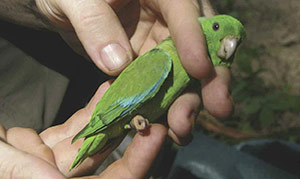At the Mayan ruin of Uxmal, Mexico, bat researcher Kirsten Bohn bends down beside a narrow crack in one of the ancient limestone walls. “Do you hear them?,” she asks. “The twittering? That’s our bats, and they’re singing.”
I lean in, too, and listen. It takes a moment for my ears to adjust to the bats’ soft sounds, and then the air seems to fill with their birdlike trills, chirps and buzzes.
The twittering calls are the songs of Nyctinomops laticaudatus, the broad-eared bat—one of several species of bats that scientists have identified as having tunes remarkably similar to those of birds. Like the songs of birds, bats’ melodies are composed of multiple syllables; they’re rhythmic and have patterns that are repeated.
And like birds, these bats sing not during the dark of night, but in the middle of the day, making it easy for us to see them, too.
Bohn, a behavioral ecologist at Florida International University in Miami, presses her face against the crack in the wall, and squints. “Well, hello there,” she says. I follow her example, and find myself eyeball-to-eyeball with one of the bats that’s sandwiched inside. He scuttles back, but his jaws chatter at me, “Zzzzzzzz.”
“He’s telling us to back off, to go away,” Bohn says, translating. “He wants to get back to his singing.”
That suits Bohn, who has traveled to Uxmal to record the broad-eared bats’ tunes for her study on the evolution and function of bat song—research that may help decode what the bats are saying to one another with their songs, and even teach us something about the origins of human language.
Not so long ago, most animal scientists and linguists regarded the sounds that animals and humans make as markedly different. Language was considered to be something only humans possessed; supposedly it appeared de novo instead of evolving via natural selection. And animals were regarded as incapable of intentionally uttering any sound. Songs, barks, roars, whistles: These were involuntary responses to some stimulus, just as your knee jerks when your doctor taps it. But since the 1990s, the notion of language as a uniquely human skill has fallen to the wayside as researchers in genetics, neurobiology and ethology discover numerous links between animal vocalizations and those of humans.
 Take grammar and syntax, the rules that determine how words can be combined into phrases and sentences. Most linguists still insist that animal calls lack these fundamental elements of language. But primatologists studying the vocalizations of male Campbell’s monkeys in the forests of the Ivory Coast have found that they have rules (a “proto-syntax,” the scientists say) for adding extra sounds to their basic calls. We do this, too. For instance, we make a new word “henhouse,” when we add the word “house” to “hen.” The monkeys have three alarm calls: Hok for eagles, krak for leopards, and boom for disturbances such as a branch falling from a tree. By combining these three sounds the monkeys can form new messages. So, if a monkey wants another monkey to join him in a tree, he calls out “Boom boom!” They can also alter the meaning of their basic calls simply by adding the sound “oo” at the end, very much like we change the meanings of words by adding a suffix. Hok-oo alerts other monkeys to threats, such as an eagle perched in a tree, while krak-oo serves as a general warning.
Take grammar and syntax, the rules that determine how words can be combined into phrases and sentences. Most linguists still insist that animal calls lack these fundamental elements of language. But primatologists studying the vocalizations of male Campbell’s monkeys in the forests of the Ivory Coast have found that they have rules (a “proto-syntax,” the scientists say) for adding extra sounds to their basic calls. We do this, too. For instance, we make a new word “henhouse,” when we add the word “house” to “hen.” The monkeys have three alarm calls: Hok for eagles, krak for leopards, and boom for disturbances such as a branch falling from a tree. By combining these three sounds the monkeys can form new messages. So, if a monkey wants another monkey to join him in a tree, he calls out “Boom boom!” They can also alter the meaning of their basic calls simply by adding the sound “oo” at the end, very much like we change the meanings of words by adding a suffix. Hok-oo alerts other monkeys to threats, such as an eagle perched in a tree, while krak-oo serves as a general warning.
Scientists have found—and decoded—warning calls in several species, including other primates, prairie dogs, meerkats and chickens. All convey a remarkable amount of information to their fellows. The high-pitched barks of prairie dogs may sound alike to us, but via some variation in tone and frequency he or she can shout out a surprisingly precise alert: “Look out! Tall human in blue, running.” Or, “Look out! Short human in yellow, walking!”
Many animals use their calls to announce that they’ve found food, or are seeking mates, or want others to stay out of their territories. Ornithologists studying birdsong often joke that all the musical notes are really about nothing more than sex, violence, food and alarms. Yet we’ve learned the most about the biological roots of language via songbirds because they learn their songs just as we learn to speak: by listening to others. The skill is called vocal learning, and it’s what makes it possible for mockingbirds to mimic a meowing cat or a melodious sparrow, and for pet parrots to imitate their owners. Our dogs and cats, alas, will never say “I love you, too” or “Good night, sweetheart, good night,” no matter how many times we repeat the phrases to them, because they lack both the neural and physical anatomy to hear a sound and then repeat it. Chimpanzees and bonobos, our closest relatives, cannot do this either, even if they are raised from infancy in our homes.
Via vocal learning, some species of songbirds acquire more than 100 tunes. And via vocal learning, the chicks of a small parrot, the green-rumped parrotlet, obtain their “signature contact calls”—sounds that serve the same function as our names.
A few years ago, I joined ornithologist Karl Berg from the University of Texas in Brownsville at his field site in Venezuela where he studies the parrotlets’ peeping calls. Although the peeps sound simple to our ears, Berg explained, they are actually complex, composed of discrete sequences and phrases. A male parrotlet returning to his mate at their nest, a hollow in a fence post, makes a series of these peeps. “He calls his name and the name of his mate,” Berg told me, “and then he’s saying something else. And it’s probably more than just, ‘Hi Honey, I’m home.’” Because the female lays eggs throughout the long nesting season, the pair frequently copulates. And so, Berg suspects that a male on his way home after laboring to fill his crop with seeds for his mate and their chicks, is apt to call out, “I’ve got food, but I want sex first.” His mate, on the other hand, is likely hungry and tired from tending their chicks. She may respond, “No, I want to eat first; we’ll have sex later.” “There’s some negotiating, some conversation between them,” Berg said, “meaning that what one says influences what the other says next.”
 Berg discovered that parrotlets have names by collecting thousands of the birds’ peeps, then converting them to spectrograms, which he subsequently analyzed for subtle similarities and differences via a specialized computer program. And how does a young parrotlet get his or her name? “We think their parents name them,” Berg said—which would make parrots the first animals, aside from humans, known to assign names to their offspring.
Berg discovered that parrotlets have names by collecting thousands of the birds’ peeps, then converting them to spectrograms, which he subsequently analyzed for subtle similarities and differences via a specialized computer program. And how does a young parrotlet get his or her name? “We think their parents name them,” Berg said—which would make parrots the first animals, aside from humans, known to assign names to their offspring.
Parrotlets aren’t the only animals that have names (or to be scientifically accurate, signature contact calls). Scientists have discovered that dolphins, which are also vocal-learners, have these calls, although these seem to be innate; the mothers aren’t naming their calves. And some species of bats have names, which they include when singing, and in other social situations.
Bats sing, for the same reason birds do: to attract mates and to defend territories. They’re not negotiating or conversing, but their lovelorn ditties are plenty informative nonetheless. After analyzing 3,000 recordings of male European Pipistrellus nathusii bats, for instance, a team of Czech researchers reported that the songs always begin with a phrase (which the scientists termed motif A) announcing the bat’s species. Next comes the vocal signature (motifs B and C), information about the bat’s population (motif D), and an explanation about where to land (motif E).
“Hence, translated into human words, the message ‘ABCED’ could be approximately: (A) ‘Pay attention: I am a P.nathusii, (B,C) specifically male 17b, (E) land here, (D) we share a common social identity and common communication pool,’” the researchers wrote in their report.
Bohn suspects that the tunes of her bats at Uxmal convey the same type of information. “The guys are competing for females with their songs,” she says, “so they can’t afford to stop singing.” She doesn’t yet know what the females listen for in the voice of a N.laticaudatus, but expects that something in a male’s intonation or his song’s beat gives her clues about his suitability as a mate.
But her focus is on another question: Are these bats long-term vocal learners, as are humans and some species of birds, such as parrots? “If they are,” she explains, “then they might be a good model for studying the origins of human speech”—which would make bats the first mammal ever used for such research.
Bohn had earlier recorded some of the bats’ songs, and digitally altered these so that they sounded like the refrains of different bats—strangers. At the wall, she attaches a pair of microphones and a single speaker to a tripod, and points the equipment at the fissure, where the bats sing. Pushing a button on her laptop, she broadcasts the remixed bat songs to the tiny troubadours, who respond with even louder twitters, trills, and buzzes. Bohn watches their responses as they’re converted into sonograms that stream across her laptop’s screen like seismic pulses. These are territorial buzzes and contact calls, Bohn explains. “They know there’s an intruder.” She’s silent for a moment, and then beams. “Yes! One of the guys is trying to match the intruder’s call. He doesn’t have it exactly right, but he’s close—he’s so close, and it’s hard.”
But there it was: the first bit of evidence that bats are life-long vocal learners. Just like us.
